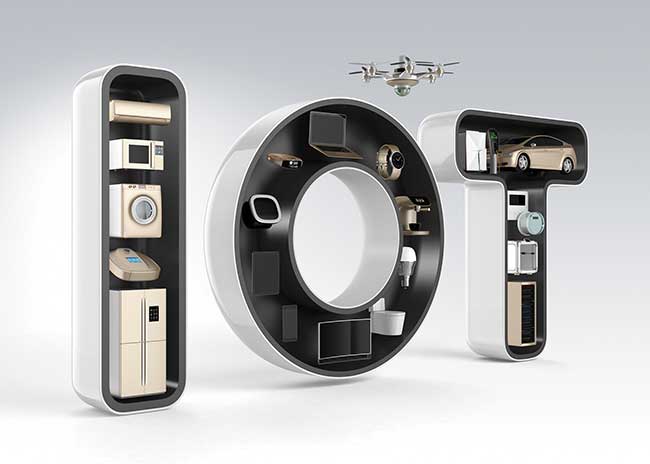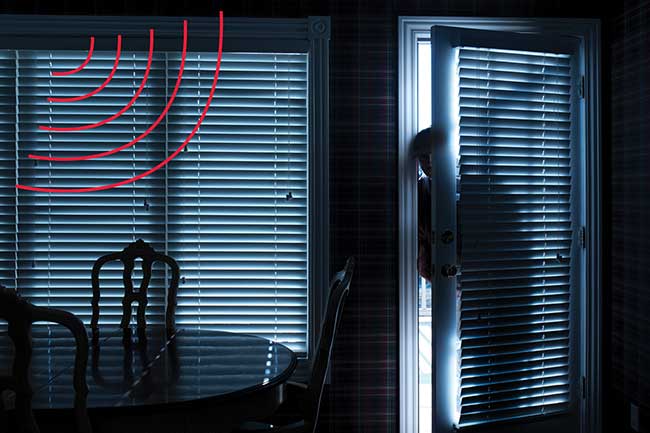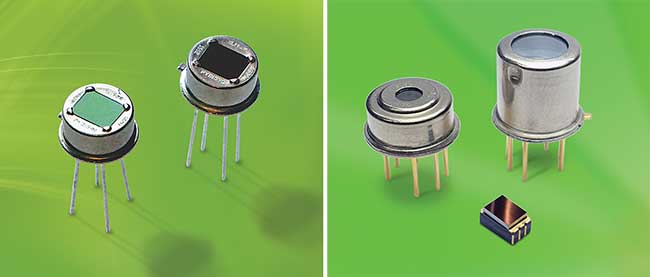From smart thermostats to sophisticated home security systems, IR sensors that detect presence and motion are making smart homes a reality.
WOLFGANG SCHMIDT, EXCELITAS TECHNOLOGIES CORP.
Dramatic advancements in smart technology and the Internet of Things (IoT) have occurred over the past decade, with powerful implications for industry and our everyday lives, enabled in no small measure by the development of increasingly sophisticated sensors. Today, electronic sensors and detectors allow for unprecedented automation capabilities in automobiles, manufacturing equipment, consumer products, and homes. The proliferation of mobile devices and their associated computing power, specialized apps, and virtually constant connectivity are driving consumer demand for more integrated and intelligent electronics to automate a growing variety of functions of daily life.

IoT is driving rapid growth in the smart home technology sector and demands smarter IR sensor technology to support the ever-growing range of smart home connectivity innovations. Courtesy of Excelitas Technologies Corp.
Fueling consumer appetites, rapid innovations have resulted in a new generation of smart devices to process everyday routines quickly and automatically. With the help of constantly advancing interfaces, the devices enable, disable, and process preprogrammed functions. The more complex and automated those functions become, the more sensory data input the electronic devices require from their operating environments — including temperature, motion, and human presence — to activate and interact accordingly.
Thermal IR detection
For example, air-conditioning and heating systems are among the heaviest contributors to household power consumption. A smart thermostat using IR sensors can perform motion- and presence-controlled operations to save energy and keep the climate comfortable. Sophisticated HVAC systems can make use of IR sensors to scan a room, prepare a heat map, and control the temperature of the air supply. IR sensors provide the necessary information about the environment in real time to automatically activate and control the thermostat. By providing detailed thermal information about the room, even the heat of sunlight moving across and into windows may be calculated into the cooling or heating requirement.

Motion detection is a key component in the advent of smart home products and systems. Courtesy of Excelitas Technologies Corp.
Thermal IR sensors are particularly well suited for machine-to-human interface because of their performance versatility, ease of integration, relative low cost, and sensitivity to human heat. Significant advances in IR sensing technologies are helping streamline system integration to meet the highly competitive and breakneck time-to-market windows demanded for consumer product development.

Thermal IR motion detection is a mainstay of sensor technology in intrusion alarms and home security systems. Courtesy of Excelitas Technologies Corp.
As product applications expand, several imperatives have surfaced for meeting the growing sensory needs of smart devices, including miniaturization, software-controlled flexibility, power efficiency, sensitivity enhancements, and ease of integration with product designs. These improvements work together and, in many cases, enable one another.
Miniaturization
Consumers demand increasingly compact and convenient iterations of smart devices, with smaller footprints and minimal visibility. Thus, OEMs are looking for ways to pack more technology and function into smaller devices as smart technologies find practical uses in homes and personal devices. This requires smaller sensor components and designs that are both compact and functional enough for the smart systems themselves to become practically invisible. The goal is to conserve space and allow devices to be integrated into their application environment as aesthetically as possible. New packages such as Excelitas’ SMD (surface-mount device) Thermopile IR detectors provide significant size reductions and thus improve space efficiency compared to compact traditional transistor outline (TO) package designs with integrated lenses.
SMD housings provide machine-assembled production and, as such, are preferred for the efficient production lines needed to meet the high-volume demands of rapidly growing consumer product segments.
The smaller footprint of SMD packaged sensors accommodates more parts per square millimeter to miniaturized sensors that support increasingly compact electronic host device designs. In line with the smaller footprint is the need to shrink optical systems and make them as invisible as possible. Fresnel-type plastic lenses, traditionally used to provide performance required for longer-range detection applications, are considered to be rather bulky. When downsizing those lenses for a smaller-footprint device, the IR sensor must compensate by providing higher sensitivity.
Advances in proprietary sensor substrate designs are yielding greater sensor area, which translates to improved sensitivity (such as quicker triggering from weaker event signals) and extended effective sensing range. Some of today’s latest SMD sensor designs are fully capable of effective event detection at ranges up to 3 m with no need for bulky magnifying lenses or windows, thus promoting further space efficiency in host system designs.
Improved signal processing
Coupled with miniaturization, enhanced sensor flexibility and software-controlled functionality promote space conservation and versatility for designers of smart products. Advanced ASICs and improved signal processing in digital IR sensor technology are now allowing IR sensors to monitor and detect multiple factors and distinguish between motion-detection events and presence monitoring. This can streamline the ability to employ various sensor points in a host system mesh network and communicate specific data from various points to the host system’s central control.
As an example, in a smart home’s HVAC control system, a sensor network could detect human entry to activate the system out of “away” mode, monitor human presence in a particular activated zone, detect motion as people move into other zones of the smart home, and ultimately monitor/report ambient temperatures throughout the home, which could be subject to variables such as moving sun exposure, nightfall, or weather fluctuations. It is this type of network integration that will continue to drive the move to digital sensors and expand the use of IR sensing in consumer-related applications.
Prolonged power efficiency
Optimizing a sensor’s power requirement not only prolongs the in-service life of remote and mobile smart devices, but, again, it will reduce the device footprint by significantly minimizing power requirements. Lithium batteries have dramatically enhanced device mobility, using small and highly efficient rechargeable batteries — first with smartphones, and now with other products such as electric cars and e-bikes. Lithium battery-operated smart products and systems in home devices are now reducing the need for hard-wired installations. Light switches, phones, doorbells, and internet protocol (IP) cameras are just a few examples.

Excelitas Low-Power DigiPyro 1500 series sensors have been engineered to run on 1.8-V power supply to extend in-field service life and offer space economy in reducing power supply requirements for smart home and portable electronic equipment. Courtesy of Excelitas Technologies Corp.
For these devices, the operating time before recharge becomes a vital asset. For example, IP cameras may be installed in locations that the user will not want to access on a daily basis for recharge. This makes lithium batteries’ ability to provide months or years of battery operation highly advantageous. For battery-driven devices to take advantage of low-voltage electronics, many microprocessors now offer 1.8-V operation. In connection with low current consumption, the overall power budget is reduced and long-term operation may be achieved. This requires newly developed sensors that also operate at 1.8 V and need less current, a technical breakthrough achieved only recently.
Greater sensitivity
One important aspect to power efficiency and performance is the ability for passive sensors to operate in “sleep” mode, using the lowest possible power draw while on standby, with a lightning-quick wake-up capability to activate the host smart device.
Thermal IR sensors are particularly well suited for machine-to-human interface because of their performance versatility, ease of integration, relative low cost, and sensitivity to human heat.
For a security or home surveillance camera, for example, this can make a big difference in efficacy — the camera can be set to “wake” out of standby mode and autofocus quickly enough to capture a meaningful image of motion across a field of view. This also extends the service life of the device and reduces power consumption because the device only uses full power when it detects human presence.
Acute sensitivity is required even when the device is in sleep mode to enable the necessary wake-up and activation speed. Usually, pyroelectric detectors and sensors are used in these applications. They provide high sensitivity and frequency response for long-range motion detection. Feeding the motion-based signal directly into a hosting microprocessor enables the best possible response and sensitivity, which then may be processed with software-based routines that result from environmental conditions and settings.
The smart product space is fast-paced and volatile. An OEM’s ability to develop and introduce a product to market in short turn can make the difference between product success and failure.
OEM design engineers need easily integrated sensors to enable shorter product design cycles. Development time can be condensed by designing electronics with existing design blocks, preferably digital ones, since most of today’s electronic devices focus on digital technology. This means sensors of all kinds need to be digital and capable of dropping in and communicating with the surrounding electronics.
Smart devices will continue to proliferate and gain an ever-growing role in our everyday lives. Battery-operated switches, IP cameras, and safety lights increase the general security and convenience in our living and working environments, and at the same time they promote energy efficiency. When connected by the IoT, the functionality will become even more intelligent and convenient.
More than that, the adaptation of our environment based on presence and motion will become a commodity. The
demand for more sophisticated interactivity in new applications will drive continuing advances in the technologies that enable them, including the innovations in sensor technology described above. Sensors — especially IR sensors — will undoubtedly continue to perform and evolve as mission-critical enabling technologies in the IoT and smart products sector.
Meet the author
Wolfgang Schmidt is the sensors product manager for Excelitas Technologies. He has more than 30 years’ experience in thermal IR sensing and is passioniate about increasing the use of sensors in smart home applications; email: [email protected].